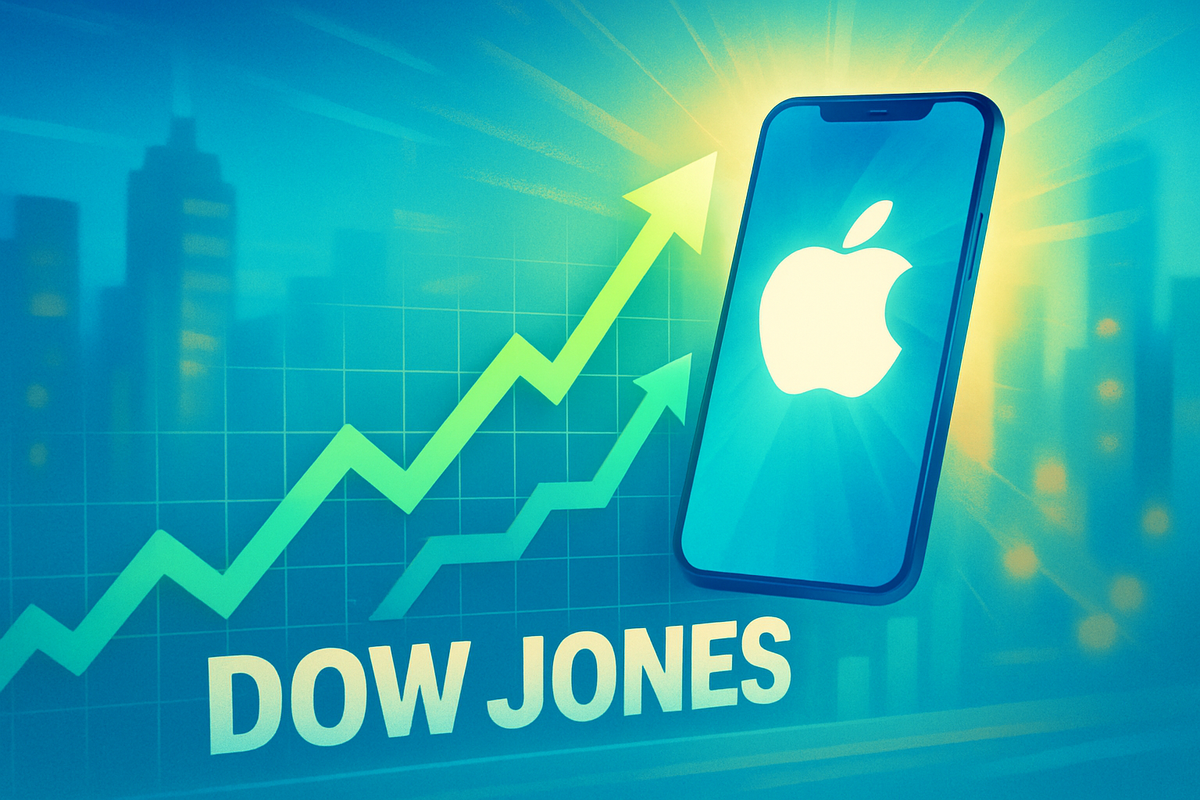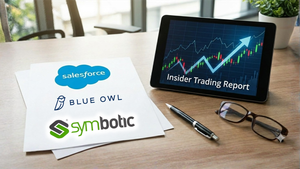
MarketMinute exclusively reports on a robust Monday for U.S. equities, as the Dow Jones Industrial Average (DJIA) soared approximately 400 points, marking a significant acceleration in the ongoing market rally. This powerful upward momentum was largely spearheaded by tech giant Apple Inc. (NASDAQ: AAPL), whose stock experienced a notable surge, injecting renewed optimism into the technology sector and the broader market. Investors are keenly watching how this resurgence, fueled by a confluence of strong corporate earnings and a perceived softening in trade rhetoric, will shape the financial landscape in the coming days. The rally underscores a prevailing sentiment that robust economic fundamentals and anticipated monetary policy adjustments are currently outweighing short-term political uncertainties, including an ongoing federal government shutdown.
Market Explodes Higher: Apple Leads the Charge on October 20, 2025
On Monday, October 20, 2025, the U.S. stock market witnessed a powerful surge, with the Dow Jones Industrial Average climbing over 450 points, a substantial gain of 0.86% to reach 46,587.56. The broader market also participated vigorously, as the S&P 500 advanced 1.03%, and the tech-heavy Nasdaq Composite led the charge with an impressive 1.39% rally. This market acceleration was largely propelled by Apple Inc. (NASDAQ: AAPL), which saw its shares climb approximately 4.5% to reach an all-time high of $262.79. This marked Apple's strongest single-day gain in several weeks and was instrumental in restoring momentum to the mega-cap technology sector.
The rally was ignited by several key catalysts. Pre-market indicators showed U.S. stock index futures trending upwards, setting a positive tone for the day. A primary driver was a report from Counterpoint Research, indicating robust demand for Apple's new iPhone 17 series. The report highlighted that the iPhone 17 outperformed its predecessor, the iPhone 16, by 14% during its first ten days of availability in the U.S. and China, with Chinese demand nearly doubling. This strong sales data for Apple's flagship product provided a significant boost not only to Apple but also to its suppliers and the broader technology sector.
Beyond Apple's stellar performance, hopes for a resolution to the ongoing U.S. federal government shutdown, now in its twentieth day, contributed to investor optimism. Rumors and statements from White House officials suggested a potential for a near-term funding agreement. Additionally, the third-quarter earnings season was in full swing, with a majority (76%) of S&P-listed companies reporting better-than-expected earnings and revenue, reassuring investors about the underlying health of the economy. Major U.S. banks had previously shattered Q3 expectations, driven by strong investment banking and trading activity, further bolstering the financial sector.
The market also responded positively to indications of easing inflation concerns, suggested by recent Consumer Price Index (CPI) reports, which reduced fears of a deep recession. Futures trading predicted a high likelihood of further Federal Reserve rate cuts by year-end, a generally positive signal for equities. Lastly, reports of easing trade tensions between the U.S. and China, including President Trump's remarks about potentially lowering tariffs if China reciprocated, contributed to a more positive global market outlook, fostering a "risk-on" environment.
Winners and Losers: The Ripple Effect Across Public Companies
The robust market rally on October 20, 2025, spearheaded by Apple's (NASDAQ: AAPL) exceptional performance, has created clear winners and losers across various sectors, highlighting the interconnectedness of the financial ecosystem. Apple itself is a significant winner, with its stock surging on the back of strong iPhone 17 sales data. This positive momentum is expected to directly boost its revenue and profitability, further solidifying its market leadership in the premium smartphone segment and enhancing its overall valuation.
The ripple effect extends directly to Apple's extensive supply chain. Semiconductor suppliers like Taiwan Semiconductor Manufacturing Co. (NYSE: TSM) and Broadcom (NASDAQ: AVGO) are poised to benefit significantly. As key manufacturers of chips and components for Apple's devices, increased iPhone 17 sales translate directly into higher demand for their products, driving their revenues and stock prices upwards. Similarly, other component manufacturers and assembly partners within Apple's ecosystem are likely to see increased order volumes and improved financial outlooks.
Beyond Apple and its direct suppliers, the broader technology sector experienced a significant uplift. Other mega-cap tech companies, including Amazon (NASDAQ: AMZN), Microsoft (NASDAQ: MSFT), Alphabet (NASDAQ: GOOGL), and Tesla (NASDAQ: TSLA), saw their shares rise. This indicates renewed investor confidence in the growth prospects of the technology sector as a whole, particularly with enthusiasm around artificial intelligence continuing to drive investment.
Conversely, companies heavily reliant on consumer discretionary spending that might face increased competition for consumer wallets from high-priced tech gadgets could indirectly face pressure, though the overall positive economic sentiment might mitigate this. Additionally, sectors that are perceived as "safe-haven" assets might see some rotation out of them if the market continues its bullish trend, although gold (COMEX: GC=F) did see a jump, suggesting some underlying caution or hedging. Companies with weaker earnings reports or those facing specific industry headwinds might find it harder to attract investor capital in a market where strong performers are being rewarded.
Wider Significance: A Broader Market Reassessment
This significant market rally, particularly on the back of Apple's (NASDAQ: AAPL) resurgence, carries wider implications for the financial landscape, signaling a potential reassessment of market dynamics and investor sentiment. The event fits into broader industry trends emphasizing the enduring power of mega-cap technology companies, especially those with strong product cycles and robust global demand. Apple's performance underscores that despite geopolitical tensions and economic uncertainties, innovative products can still drive substantial market value and investor confidence.
The potential ripple effects on competitors and partners are considerable. For competitors in the smartphone market, such as Samsung (KRX: 005930) and Google's (NASDAQ: GOOGL) Pixel line, Apple's strong iPhone 17 sales could intensify competitive pressures, forcing them to innovate further or adjust their market strategies. Partners within the technology ecosystem, including app developers and accessory manufacturers, stand to benefit from the increased installed base of iPhone 17 users. The rally also highlights the continued dominance of the "Magnificent Seven" tech stocks in driving overall market gains, raising questions about market concentration and the breadth of future rallies.
Regulatory or policy implications might also emerge from such a concentrated rally. Increased scrutiny on the market power of dominant tech companies, including Apple, could intensify, potentially leading to renewed antitrust discussions or calls for regulatory oversight, especially if their market capitalization continues to grow disproportionately. The ongoing federal government shutdown, while seemingly overcome by market optimism today, remains a significant political backdrop. Its eventual resolution or prolonged impact could still introduce new policy considerations for businesses and investors.
Historically, periods of strong tech-led rallies often precede broader market shifts. Comparisons can be drawn to dot-com era booms or other periods where a few dominant companies drove significant index gains. While not necessarily indicative of an impending bubble, it does prompt questions about sustainable growth and market diversification. The current rally, occurring amidst easing inflation concerns and expectations of Fed rate cuts, suggests a market environment that is becoming more conducive to growth-oriented stocks, a stark contrast to periods of aggressive monetary tightening. This event could mark a pivotal moment where investor focus shifts more definitively towards growth prospects rather than solely on inflation and interest rate risks.
What Comes Next: Navigating the Evolving Market Landscape
The Dow's substantial jump and Apple's (NASDAQ: AAPL) leading role on October 20, 2025, herald a dynamic period for the financial markets, presenting both short-term opportunities and long-term challenges. In the short term, the positive momentum from strong corporate earnings and easing trade tensions could fuel a continued upward trajectory for equities, especially in the technology sector. Investors might see further rotation into growth stocks, and market breadth could continue to improve as smaller-cap companies also gain traction. However, the ongoing federal government shutdown remains a wildcard, and any unexpected negative developments on that front could introduce volatility.
Looking further ahead, the long-term possibilities hinge on several factors. The sustained demand for Apple's iPhone 17 series suggests continued strength for the company and its ecosystem, but future innovation and market saturation will be key. For the broader market, the expectation of further Federal Reserve rate cuts could provide a supportive monetary policy environment, potentially extending the current bull run. However, the market will closely watch for any signs of re-accelerating inflation or shifts in economic data that could alter the Fed's stance. Geopolitical developments, particularly regarding U.S.-China trade relations, will also play a crucial role in shaping investor confidence.
Potential strategic pivots or adaptations will be required for companies and investors alike. Businesses in the technology sector may need to double down on innovation, particularly in areas like artificial intelligence, to maintain growth momentum. Non-tech companies might need to assess how technological advancements and shifts in consumer behavior, often driven by tech giants like Apple, impact their industries. For investors, a balanced approach might be crucial, considering the potential for continued tech leadership alongside opportunities in sectors benefiting from broader economic recovery and potential rate cuts.
Market opportunities could emerge in sectors that are either directly benefiting from tech advancements or those that are poised for a rebound as economic conditions improve. This includes not only technology and its supply chain but also potentially consumer discretionary, financials, and industrials if the positive sentiment persists. Challenges may arise from elevated valuations in certain segments, increasing the risk of sharper corrections if earnings fail to meet high expectations or if macroeconomic conditions deteriorate. Potential scenarios range from a sustained, broad-based rally driven by strong fundamentals and supportive policy to a more volatile environment if geopolitical risks or economic headwinds re-emerge.
Comprehensive Wrap-up: A Moment of Optimism Amidst Uncertainty
Today's remarkable rally, with the Dow Jones Industrial Average soaring and Apple (NASDAQ: AAPL) leading the charge, serves as a powerful testament to the market's resilience and capacity for swift upward movement. The key takeaways from this event are manifold: the enduring influence of mega-cap technology companies, the significant impact of strong product cycles (as evidenced by the iPhone 17's success), and the market's ability to find optimism amidst broader political and economic uncertainties. The confluence of robust corporate earnings, easing trade tensions, and hopes for monetary policy accommodation created a "powerful tailwind" that propelled equities higher.
Moving forward, the market appears to be in a phase where fundamental strengths, particularly in corporate performance, are being rewarded. While the federal government shutdown remains a point of concern, investors have largely chosen to focus on the positive economic indicators and the prospect of a more favorable interest rate environment. This suggests a potential for continued growth, though the path may not be without its bumps. The rally also highlighted a broadening of market participation, with small-cap stocks and other sectors joining the tech-led surge, indicating a healthier underlying market structure than rallies solely driven by a few giants.
The lasting impact of this event could be a reinforcement of the bullish sentiment that has been building, potentially setting the stage for a strong close to the year. It underscores the importance of innovation and strong consumer demand in driving corporate success and, by extension, market performance. For investors, the significance lies in recognizing the current drivers of market momentum while remaining vigilant about potential risks.
In the coming months, investors should closely watch for several key indicators: the resolution of the government shutdown, further developments in U.S.-China trade relations, the Federal Reserve's stance on interest rates, and the continued performance of corporate earnings, particularly from the technology sector. The market's ability to sustain this rally will depend on these factors aligning to support continued economic expansion and corporate profitability.
This content is intended for informational purposes only and is not financial advice






